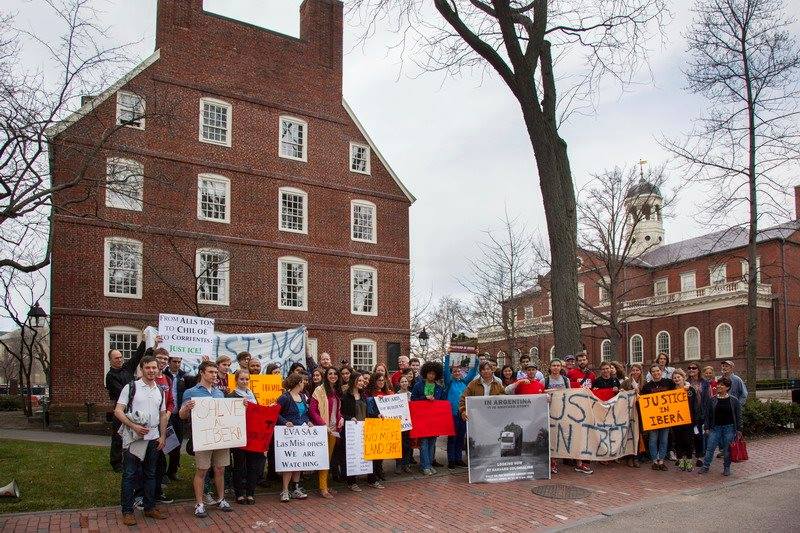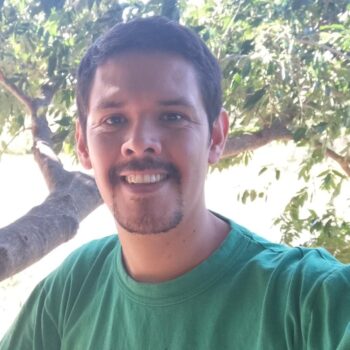Shifts lasting 12 days without a break. Managers jolting workers awake at two in the morning to demand they start working. Spiders and bats infesting company dormitories.
Until recently, this was the reality for workers at EVASA, a timber company in Corrientes, Argentina — a poor, rural province located 12 hours by bus from the capital of Buenos Aires. EVASA grows pine forests and sells the wood for industrial production.
Harvard Management Company (HMC) — the university’s investment arm, which is responsible for its $53.2 billion endowment — purchased the company from North Face founder Doug Tompkins in 2007 as part of a strategy to expand the endowment’s reach into natural resources. By that point, Harvard had been hiring investment managers with expertise in natural resources, including forestry, for several years. HMC’s interest in natural resources led it to search for investment opportunities that retail investors wouldn’t pursue — including in smaller companies and areas with weak government regulations, like Corrientes. EVASA claimed to be a sustainable operation; the company even brandished a Forest Stewardship Council (FSC) seal.
After HMC purchased EVASA, the company’s management made a number of decisions to extract more profit: accelerating expansion into the nearby Iberá Wetlands, reducing company expenditures for community projects, and delaying improvements to worker housing. Workers became subcontractors rather than employees and so, while wages did not fall, they also did not keep up with inflation.
As environmental justice organizers in northeastern Argentina, we were alarmed by these incursions on our local ecosystem. Through a comrade at Occupy Harvard, we reached out to student organizers — who we knew had key leverage in the belly of the beast — to help us mount an international campaign to hold Harvard accountable. We also came across a group called the Responsible Investment at Harvard Coalition; we worked with them to coordinate a student visit to Corrientes so that they could gather information that could assist their campaigns in the US.
In the years that followed, we hosted two student organizers in Corrientes, traveled to Harvard’s campus, collaborated on the publication of a report documenting Harvard’s impact, and organized protests in local communities. Our goal was to stop EVASA’s expansion into the nearby wetlands, remove the timber plantations closest to homes, and force the company to comply with local labor law. As a result of the campaign, EVASA improved the living conditions of the workers, but we did not win concessions on environmental issues. While we have seen some successes, the work of the coalition continues to date. Along the way, we have learned several lessons about border-crossing organizing: the importance of identifying the real decision-makers and centering the demands of frontline communities.
Identifying the Real Decision-Makers
The Indigenous communities surrounding these important wetlands have been organizing for justice for years, many of them united through our organization, Guardians of Iberá. A key component of our approach has been to engage youth in local organizing groups, even in small towns of only a few dozen families. These groups are connected through a regional body, which had been fighting to protect the Esteros del Iberá (one of the most important wetlands in Argentina) from industrial development by small businesses and large multinational corporations.
We focused on EVASA because, unlike other companies in the area, the owner, North Face founder Doug Tompkins, had a public profile as a conservationist. When he sold the company, we were worried we would have no leverage. But we soon realized we had an even more compromised target in Harvard.
Today, the 20 largest university endowments in the United States hold more than $648 billion in assets. Harvard’s $53.2 billion represents more than eight percent of that sum, and its behavior matters to the other endowment managers, who pay close attention to Harvard’s decisions. Increasingly, higher education observers note that endowments are the tail wagging the dog at elite private schools in the United States, which often operate as “hedge funds with schools attached.” Higher education institutions are thus important strategic targets in the financial world.
Unlike many other forms of global capital, university endowments are highly sensitive to public pressure, making Harvard a prime target for our campaign. From the Anti-Apartheid Movement to the Fossil Fuel Divestment Movement, there is a rich tradition of endowment activism successfully leveraging the public profiles of universities to change the political landscape in the United States. But given that universities are largely publicly funded in Argentina, this was a new experience for us.
Luckily, campus workers at Harvard had already primed student organizers to think critically about the endowment. Just a year before we began organizing against Harvard, worker leaders in UNITE HERE Local 26 had organized student activists to support a successful campaign to pressure the administration to divest from a union-busting hotel company: HEI Hotels and Resorts. We invited these same students to come to Corrientes to learn about our campaign. They visited EVASA workers at their workplaces to hear their testimony and take photos, went door to door in the areas immediately surrounding Harvard-owned land, flew over EVASA’s plantations to take aerial photos, and joined community meetings organized by the local farmers union. The meetings agitated the workers and community members by asking some basic questions: what impact had EVASA had on their lives since Harvard purchased it? Who was benefiting from that suffering? What were they willing to do about it?
Centering Frontline Communities
At the same time, we worked to consolidate the support of student organizations at Harvard. Our main challenge was that we were taking on a thoroughly greenwashed target. When we approached campus groups, we faced two initial objections: 1) Since EVASA was an FSC certified timber operation, surely there must be other, worse offenders to go after? and 2) If EVASA is so bad, why not demand that Harvard divest?
The answer lay in what the EVASA workers knew: FSC and Harvard were the lever they needed to win. Harvard was susceptible to public pressure, and it was key to use that pressure in a way that forced Harvard to live by its stated values, not ditch the company altogether.To persuade students to support our campaign, we used FSC audit reports to substantiate worker reports of unsafe working conditions and the use of environmentally harmful chemicals. Over the course of two semesters, we built a coalition of 37 student groups to back our demands, including the Harvard Undergraduate Council, the Harvard Graduate Student Council, the Harvard Black Student Association, and The Harvard Crimson Editorial Board.
The leaders of the Responsible Investment at Harvard Coalition wrote a 42-page investigative report, published by the Oakland Institute. The report was covered by Bloomberg News and helped credential our movement in public. We also raised money from more than 400 Harvard students, alumni, and other supporters to travel to Harvard for a rally and meeting with HMC executives.
Harvard didn’t cede to demands easily. At first, they ignored us; then, they tried to slander us to the local community, even throwing a lavish event to convince the community that they were positive stewards. At the same time, Harvard did agree to some concessions, including repairing company-owned dormitories, pausing EVASA’s expansion into the Iberá Wetlands, hiring more environmental experts, and beginning to collaborate with the staff operating the nearby national park. These smaller wins were significant because they showed community members that change was possible.
According to Lucas Yacuzzi, who lives in nearby Chavarria: “The smell (in the dormitories and wetlands) had been unbearable. I walked through the timber plantations, and I saw camps without toilets, without water, with empty pesticide drums thrown everywhere. The conditions were very precarious.” After the campaign went public, “The situation quickly changed. They made repairs in the cabins where the workers live. They could finally get some rest after a long day’s work.”
That being said, we didn’t stop Harvard from pursuing its overall approach of investing in low-road natural resource companies that drive down labor and environmental standards. In fact, they went on to invest $270 million in farmland in nearby Brazil — where locals experienced similar injustices, including land grabs that forced residents off their land without compensation. From what we can gather, advocacy groups are involved in the fight, but there is no robust local organizing presence. While press reports and legal cases can be important tactics, our experience suggests local residents and students must unite in Brazil in order to transform their conditions.
Conclusion
By organizing together with Harvard students on Harvard’s campus, we forced Harvard to change some of its practices. Building coalitions with groups in the Global North, where there are better conditions for democratic participation and where the companies that destroy our territories are based, is essential to increase the chances of achieving changes that have a positive impact on the lives of our communities. This is especially essential for organizations that are in territories where state institutions are weak.
But we are clear that to fully harness the potential of organizing on college campuses, we must also develop strong coalitions among organizers in the Global South. There is currently a new group campaigning against Harvard’s land grabbing in Brazil. This is good, but we must find ways to be more systematic in uniting our struggles. We also must learn to carry out long campaigns with short, medium, and long-range objectives rather than settling for quick wins.
This summer, one of our concerns about forest plantations became a reality: hundreds of thousands of hectares of forest plantations burned in forest fires. The flames reached 30 meters and firefighters from all over the country had to travel to Corrientes to help. Among the more than one million hectares of forest plantations, native forests, and grasslands that burned for almost two months are the Harvard forest lands. The lack of land use planning and the destruction of wetlands generated by forest plantations, which we have denounced for years, aggravated the fire problem. It is urgent that, in full recognition of the climate crisis, Harvard review its companies’ land grabbing practices and forms of production. We are building the power to demand these changes, and we are confident that we will win.


